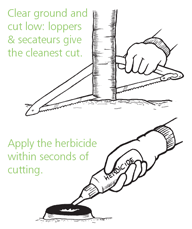 CUT AND PAINT
CUT AND PAINT
Suitable for small to medium sized woody shrubs up to 10 cm in diameter (or larger if using a chain saw). See below for trees.
- Clear around the base of the plant.
- Cut the stem horizontally as close to the ground as possible, using secateurs, loppers, or a saw. Make sure there is no soil on the cut.
- Apply herbicide to the cut stem immediately. Squeeze, not squirt if using an applicator.
- Ensure there is no runoff of poison.
- Use as little herbicide as possible
TIPS
- Make cuts horizontal to prevent herbicide from running off the stump. Sharp angled cuts are hazardous.
- Apply herbicide immediately after cutting - within a few seconds, before plant cells close and translocation of herbicide ceases.
- If plants resprout, cut and paint the shoots after suffi cient regrowth has occurred.
- Stem scraping can be very effective on certain woody weeds, e.g. Japanese Honeysuckle, Blackberry, vines and rhizomatous plants.
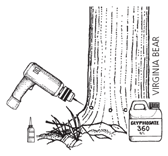
STEM INJECTION
A method for weedy trees and large shrubs.
- Use a cordless drill (9 mm bit), hammer and chisel, or brace and bit.
- Below any branches, drill or chisel holes round the base of the tree, into the sapwood, angled down at 45°, and at 5 cm intervals.
- Make the holes about 40 mm deep.
- Within a few seconds of drilling each hole, fi ll it with herbicide.
- Use this method only when falling branches, as the tree dies, will not be a safety hazard.
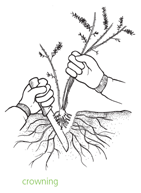 HAND REMOVAL OF WEEDS
HAND REMOVAL OF WEEDS
Suitable for seedlings, herbaceous weeds, many grass species.
- Before starting work, remove and bag seeds and fruit, and place in bin.
- If the weed has a tap root, push a narrow trowel or long knife deep into the ground beside the root. Loosen the soil. Work round the root and then work the plant out gently.
- Many plants which will not regrow from their roots (e.g. many grasses) can be crowned: see diagram to the right. Hold leaves and stems together, and use a knife to cut through all the roots below the 'crown'.
- Plants with bulbs, corms or tubers (e.g. Watsonia) may need deep digging to ensure complete removal. Bag bulbs, corms and tubers and send to the tip; do not compost.
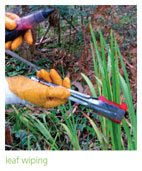 STEM & LEAF WIPING
STEM & LEAF WIPING
This method is suitable for plants with bulbs, tubers, corms or rhizomes, e.g. Watsonia.
- Remove and bag any seed or fruit.
- Using a weed wiper, start at the base and wipe all the stems and/or leaves with a dilute mix of herbicide.
- If leaves have soil on them, wipers must be regularly washed out.
Take great care when wiping: do not allow the herbicide to touch your skin or to run off into the soil, or to get on a non-target plant. There are many control methods which are specifi c to certain weeds - e.g. large infestations where spraying, or covering to exclude light may be options. Contact your local nursery for up to date techniques.
WHEN TO TREAT WITH HERBICIDE
- Apply herbicide when the plant is actively growing.
- Do not apply herbicide when the plant is under stress: extreme heat or cold, drought, waterlogging, or disease.
- Choose early morning or late afternoon in summer.
- Do not apply when wet or windy weather is anticipated.
- Treat deciduous plants in late spring or summer, when in full leaf.
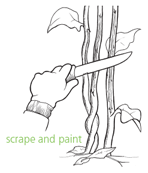 SCRAPE AND PAINT
SCRAPE AND PAINT
This method is suitable for vines and scramblers with woody stems.
- Using a knife, and starting from the base, scrape 20 to 100 cm of leafy stem to expose the sapwood below the bark.
- Within seconds, apply herbicide to the scraped area.
TIPS
- Do not ringbark the stem: scrape about one third of the diameter.
- Stems larger than 1 cm in diameter can be scraped on both sides.
- Vine curtains can be cut at chest level, then again at about 30 cm. Scrape or cut and paint these stumps.
- Blackberry can be cut back to 1 m if there are plenty of leaves; then scrape and paint the cut stems.
- Pulling vines (especially twiners) out of trees and shrubs may do a lot of damage. They can be left hanging to die.
By Law
Herbicides must be used according to the label, or according to Australian Pesticides and Veterinary Medicines Authority (APVMA)permits. If the plant on which you wish to use the herbicide is not named on the label, contact APVMA for permit information www.apvma.gov.au).
THE DIG OPTION
On previous pages you will find advice on using herbicides to control weedy plants: often this causes minimal disturbance and less germination of seedlings.
However, if you have the energy and want to minimise herbicide use, you can often take the dig option, making absolutely sure that you remove all the parts of the plant from which it can regrow.
TIPS
- Seedlings and small plants may be pulled by hand when the soil is moist.
- Try to stager weed removal. Large areas of exposed soil are an open invitation to weed invasion and erosion, carrying weed seed into the bush.
- Mulch bare soil, and stabilise it by planting bush-friendly plants into it as soon as possible.
NGIA acknowledges the Blue Mountains City Council for providing the section on controlling weeds. For further information and additional resources please contact (02) 4780 5000.